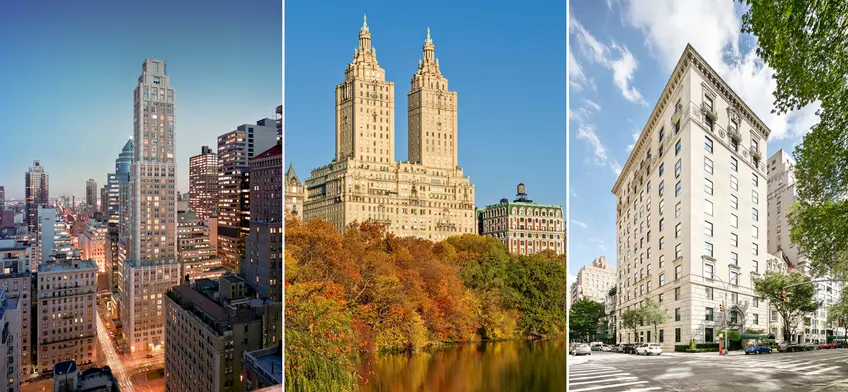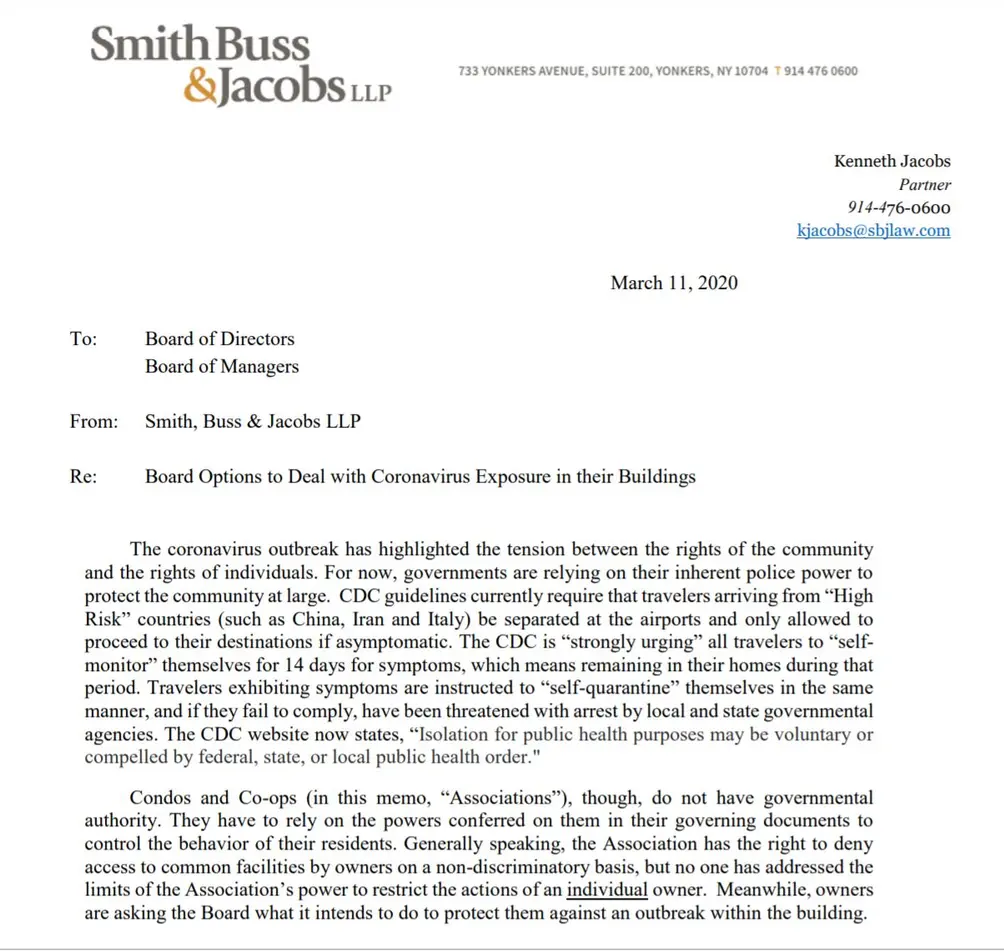 515 Fifth Avenue, The San Remo, and 927 Fifth Avenue
515 Fifth Avenue, The San Remo, and 927 Fifth Avenue
If you live in New York City, you likely live in a shared building. As everyone knows, living in a walk-up or high rise is complex. Over the coming weeks, these living arrangements are about to get a lot more complicated. You can’t take out your garbage or get your mail without entering a shared space, and social distancing is essentially impossible in an elevator. All this makes following Center for Disease Control ("CDC") and state and local guidelines on COVID-19 extremely challenging. It also means that co-op and condo boards, as well as management companies around the city, are currently wondering how to proceed.
In China, many buildings took social distancing into their own hands. By January, reports were already circulating about buildings where residents were only permitted to leave or enter on a strict schedule to ensure residents didn’t use elevators at the same time. Some buildings and neighborhoods even started to take residents’ temperatures.
Could something similar unfold in New York City? Likely not, but we are in uncharted territory, so it is difficult to know for sure what will happen next.
Could something similar unfold in New York City? Likely not, but we are in uncharted territory, so it is difficult to know for sure what will happen next.
 Full document in the link below (Smith, Buss, and Jacobs)
Full document in the link below (Smith, Buss, and Jacobs)
On March 11, Smith, Buss & Jacobs LLP, a law firm based in Yonkers, published a six-page response to COVID-19 on their website outlining just some of the complex questions and challenges boards and management companies will face over the coming weeks. This article draws on guidance from Smith, Buss & Jacobs’ March 11 briefing, similar guidance from Gallet, Dreyer, and Berkey, LLP published on March 12, and updates on the Council for New York Cooperatives and Condominiums website to explore just a few questions currently weighing on the minds of residents, boards, and building managers.
Can a building require residents to remain in their units?
As per the CDC guidelines, if one has tested positive, they are advised to “not leave, except to get medical care” and to “not visit public areas.” This suggests that it should be within a board or management company’s power to force residents who test positive for COVID-19 to remain in their unit. The question is, what constitutes a private versus public space in a shared residential building? For example, if you leave your unit to bring trash to a chute, are you in private or public? If you live with someone who has not tested positive and is not showing symptoms but who is self-isolating as a precaution, can they bring out the trash? But this is just where the ambiguity begins.If someone tests positive for COVID-19, can your building alert other residents? Should it?
According to the briefing from Smith, Buss & Jacobs, “The CDC advises that when possible, the Association should notify other owners of a known health risk in the building, but should not disclose any personal or medical information about any individual resident.” However, they further acknowledge that this sets an unclear boundary. For example, does this suggest that boards should identify which individual in the building has tested positive, identify the unit or the floor where someone has tested positive, or simply disclose that a resident in the building is ill?Smith, Buss & Jacobs advise the following: “Initially, a Board should ask a sick or quarantined individual whether they consent to disclosure of the information. If they consent in writing, the Board may make the appropriate disclosures. However, if they do not consent or fail to respond, the Board may still have a duty of disclosure but should not reveal any personal information.” They further observe, “At some point we expect that many buildings in New York City will have multiple cases of coronavirus. Some of these cases will be known and others may not. Therefore residents should assume that someone on their floor may be ill and act accordingly.”
What can buildings do if there is a suspected infected individual in the building?
On March 12, Gallet, Dreyer, and Berkey, LLP, a Manhattan-based law firm, posted the following guidelines on their website (these guidelines also currently appear on the Council for New York Cooperatives and Condominiums website):- Buildings may temporarily suspend services to public areas like gyms and conference rooms.
- Attempt to keep the names of suspected infected individuals confidential from other residents but inform all building staff that may come into contact with that individual.
- The staff should inform management of the name and address of each person suspected of being infected so management can inform the CDC and local health officials.
- Direct the building staff not to come into contact with the suspected infected or quarantined individual without following the above protocols, i.e. request the suspected individual to exit the room, wear protective face mask and properly sanitize after the visit.
- Advise all infected or quarantined persons that deliveries will be left outside the apartment door, that the delivery (or staff) person will ring the doorbell to advise of the delivery and will depart immediately without interacting with such person.
- Report to the CDC and to the city, county or district health officer any suspected infected individual who is not remaining quarantined.
Can a building bar visitors from the building, including deliveries?
As of March 19, the Council for New York Cooperatives and Condominiums was offering the following advice: “Building staff should ask all contractors, vendors and delivery persons who enter through the service door to wash their hands and any guests or delivery persons entering through the lobby to cleanse their hands at the hand sanitizer dispensers in the lobby before proceeding further into the building.”A March 19 article published by The Cooperator, however, advises that no delivery people should be permitted past the entrance of a building. Still, the same article suggests that if a resident is sick, boards may need to permit delivery persons to leave deliveries outside a resident’s door.
Can a building close a pool, playroom, gym, laundry room, or other common area?
With public gyms, pools, and playgrounds already closed, one should expect these amenities to close in residential buildings as well. However, Governor Cuomo’s guidelines did not clearly state whether or not these amenities must shut down in private buildings. Laundry rooms raise additional challenges, especially since many New Yorkers rely on the shared laundry facilities in their buildings. It seems likely, however, that buildings may impose restrictions on when and how many people at a time can access laundry facilities.Without clear guidance from New York State or a court ruling, residents in multi-unit buildings across New York City should brace themselves for a patchwork of responses over the coming weeks as boards and management companies struggle to contain COVID-19 in the nation’s most densely populated region. With the state and city having declared states of emergency, however, boards and management companies will likely be given more latitude than usual.

Contributing Writer
Cait Etherington
Cait Etherington has over twenty years of experience working as a journalist and communications consultant. Her articles and reviews have been published in newspapers and magazines across the United States and internationally. An experienced financial writer, Cait is committed to exposing the human side of stories about contemporary business, banking and workplace relations. She also enjoys writing about trends, lifestyles and real estate in New York City where she lives with her family in a cozy apartment on the twentieth floor of a Manhattan high rise.

 6sqft delivers the latest on real estate, architecture, and design, straight from New York City.
6sqft delivers the latest on real estate, architecture, and design, straight from New York City.
